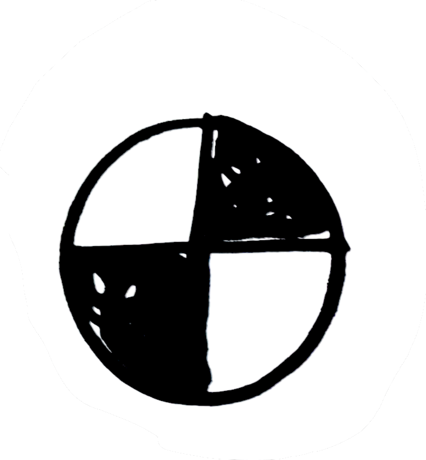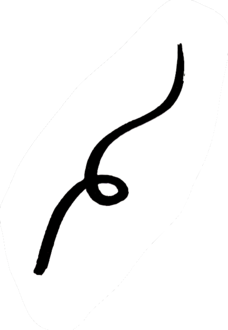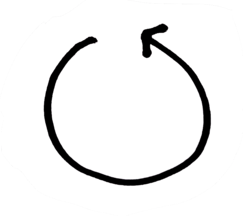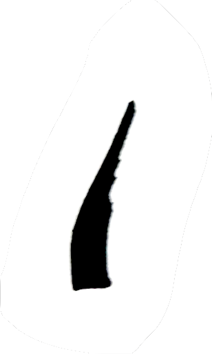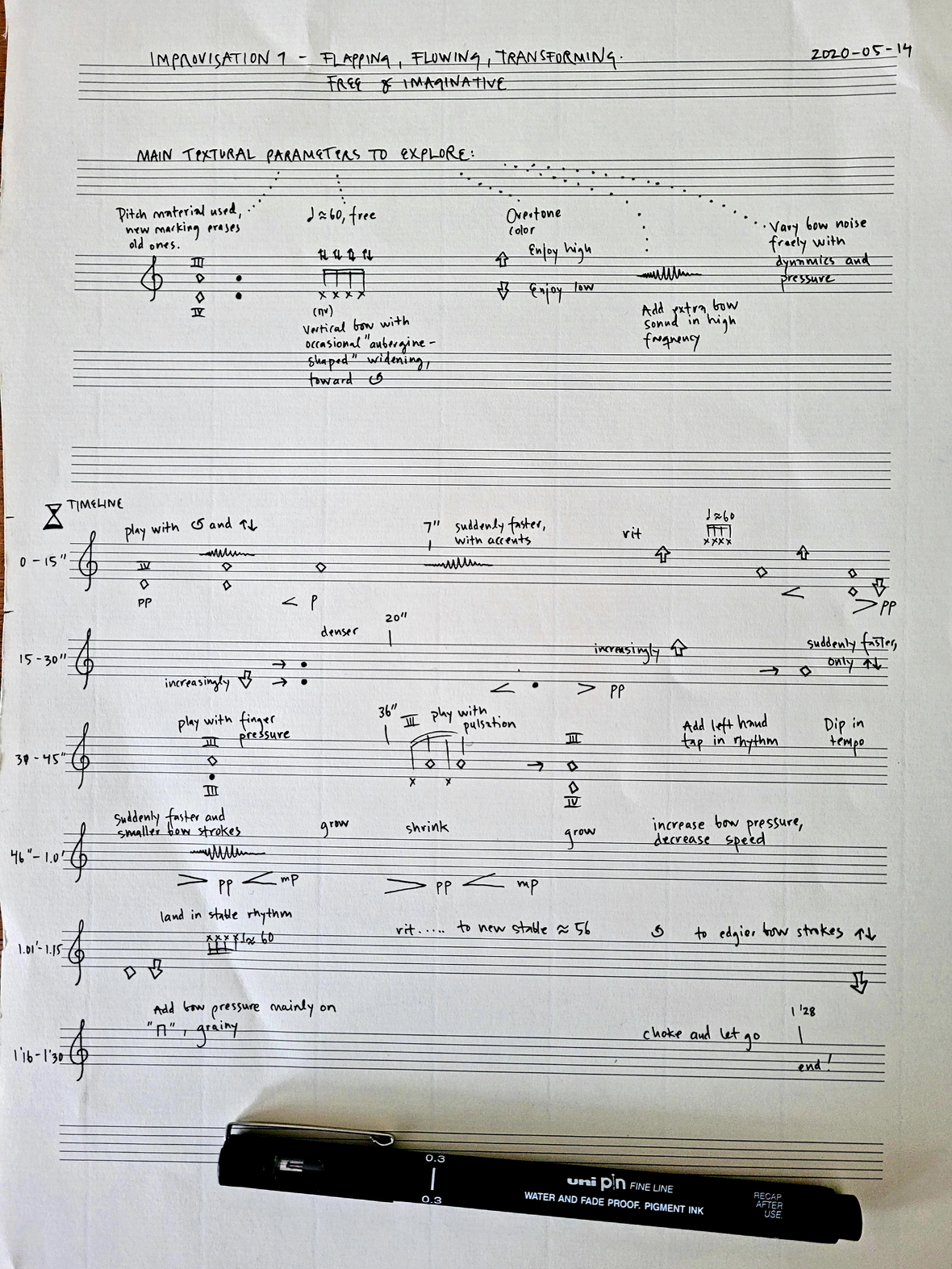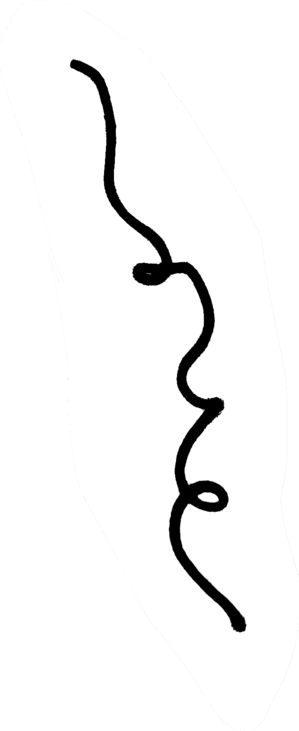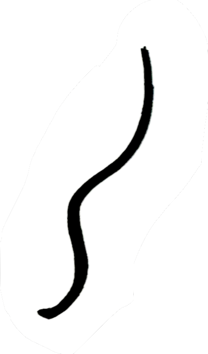Henrik Strindberg, composer, in email 2021 «I would just like to add, that if there are things you think would develop my compositional practice, that you would like to challenge me with, that is of course very exciting for me! I have composed so much music out of my own ideas, that I would be both thankful and stimulated if you gave me some input.»
DEVELOPING CONNECTION
How can we develop a collaborative compositional process, in which cyclical work modes connect us?
My search for alternatives to the traditional composer-performer-division way of working, starts with a desire to connect. To connect to collaborators through a shared compositional process, and to connect my embodied knowledge to a piece of music, a score, a performance. I wish to construct a space for connections, where ideas and materials can circulate and hybridize, and from where a shared compositional process can evolve.
Why do I search for connection in my practice? As a violinist specialized in contemporary Western classical music, I have experienced feelings of un-connectedness toward the work and its composer. I have rarely been involved in the imaginative phase of creating a new work. Instead, I have left the concept-formation of the piece to the composer. Further, evaluating musical materials has been another task reserved for the composer. Consequently, I have not been particularly involved in the compositional processes of the works I commission and perform. Traditional and applied divisions between my practice and that of the composer have separated us.
Structures regulating the notion of a musical work, as we know it, can be traced back to the early 19th century. With the concept of Werktreue, Lydia Goehr describes the performer’s loyalty to the work and subsequently to the composer. According to Goehr, Werktreue «emerged to capture the new relation between work and performance as well as that between performer and composer. Performances and their performers were respectively subservient to works and their composers». (Goehr 1994: 231) The ideal of Werktreue began catalyzing separation and a formal task division between composer and performer two centuries ago. Today, two hundred years later, the ideal of Werktreue is still influential in classical and contemporary music. Goehr’s ideas, although historically grounded, contextualize my experiences of a hierarchy and division of roles still practiced.
Looking for alternatives to the one-directional way of composing music, I direct my focus toward collaborative composition, here between Henrik Strindberg (composer) and myself (violinist Karin Hellqvist), unfolded from my viewpoint as a performer. Our collaboration is a part of my artistic PhD project at the Norwegian Academy of Music in Oslo, Transforming with the Artistic Palette, in which I experiment with ways of being active in the compositional process. In this exposition, I aim to exemplify how habitual practices can be challenged and how I have experienced the emergence of an alternative and connected work mode. Together, Henrik and I have developed a cyclical way of creating music where artistic contributions interweave and cross-fertilize, as opposed to the ‘one-way’ work relationships I have been accustomed to in my earlier practice. While creativity, even in contemporary classical music, has been located more or less exclusively in the practice of the composer (in line with the ideals of Werktreue), today we see a tendency of authorship gradually shifting from an individual and often isolated pursuit toward collective endeavors, where several agents may contribute to a compositional process. Margaret Barrett describes this shift in research and attitude, and notices that «recognition of the ways in which creativity emerges from joint effort has given rise to the investigation of creative collaborations and partnerships» (Barrett 2014: 3). My investigation aims to contribute to this growing field of studies examining creativity as a collective process, and to increase the possibilities of exchange between creative agents. Materializing like a metaphor for the collaboration with Henrik Strindberg is the breaking away from the conventional heel-to-tip way of bowing the violin. Instead, the bow moves in circles across the strings as an act of resistance – repudiation of the ‘one-way’ work mode.
In this exposition, I will share selected artistic materials from our collaborative process—sonic materials, captured when being circulated between us toward their development and refinement, video excerpts from Zoom conversations, pictures, notational fragments and transcribed dialogue. You are further invited to our workshop space, where we share suggestions and tryouts, ideas and laughter.
Henrik Strindberg (1954) is one of the leading composers in Sweden. He has an extensive catalogue of works behind him, ranging from works for solo instruments to orchestral works and chamber opera. He is a dedicated teacher of composition, currently at the Gotland School of Composition. He is also active in the progressive rock movement with the band Ragnarök. Henrik has been rewarded with several prizes for his work and his music is regularly performed by leading Swedish soloists and orchestras. Our paths crossed as Henrik composed the solo violin work Femte strängen (2009) for me, still one of the dearest works in my solo repertoire.
Karin, email: «It would be interesting to leave certain parameters open to start with. Can we leave parts free to improvise sonic timbres and textures in, to highlight the performer-specific? Each performer who performs the work then create their specific version. As a composer, what are your thoughts about such an approach?»
In conversation about different kinds of circular bowings. How is oval and circular bowing different? Karin perceives oval bowing more like a rhythmization.
THE ARTISTIC PALETTE
In my research, I develop the concept of the artistic palette—a concept connected to my artistic creativity and agency. The artistic palette comprises my embodied knowledge, contextual artistic materials, my personality, my way of communicating and intuitive aspects that I draw on in creative processes. It holds the concrete as well as the abstract—playing techniques, internalized embodied patterns, ways of phrasing and sound production, my musical taste and history as a performer. The artistic palette is dynamic, being re-constructed and re-negotiated with the experiences, relations and materials I engage with. The artistic palette develops when I explore my creativity together with Henrik in the work Cirkulära Stråk (Circular Bowings). In this process, concepts of agency, empowerment, ownership and connection are central to understand my artistic palette and to see the elements at play within it.
Henrik, email: «I’m thinking about the tension between improvisation and composition. We now have a foundation in our material: the sound characteristics and the transitions between détaché and vertical bowing techniques. If we have lists of actions, as crescendo, accents, microtonal glissandi, speed variations, dynamics, scratch tones etc., we could share them. You take some, I take some. Some (or none) we take both. Then we do every other. If you in the next phase decide on a version, that is, composing rather than improvising—how would that be?»
I introduce the concept of the artistic palette to Henrik, and explicitly and implicitly, we begin to employ it in our dialogue. As a concept, I notice how it becomes a tool on the path of dissolving the traditional task division between the performer and the composer to develop a collaborative compositional process. With it, creativity is acknowledged also in my performance practice. When reflecting on the reconstruction of practices, I read musicologist Alan Taylor (2020). According to Taylor, true collaboration unfolds when both the imaginative and the evaluative phases of creating a new work are shared. However, at the outset, sharing those creative processes is for me an unexplored territory.
Henrik, email: «I woke up this morning with an idea about those double-stops. Perhaps you could improvise with them, in a fluttery way? What happens as those quiet, meditative sounds are being articulated, circulating and colored with your specific palette?»
CONNECTING IN A SEPARATED REALITY
During the fall of 2019, we meet in person. However, soon the pandemic separates us, and connecting becomes a process unfolding online, through emails and Zoom conversations. We send materials back and forth between each other, and a cyclical mode of working evolves.
Henrik, email: «It’s so exciting to see a new email from you, knowing you have recorded or created something. We constantly develop our material — alternately!»
Sound collage of some of Karin's recordings, put together by Henrik as part of the compositional process.
As my world slows down with the pandemic, I see how time becomes an important resource in our collaboration. I feel a calm arising when we focus on process rather than on result. We have time to circulate materials between us, and to take our time to reflect and respond. I experience materials as being explored in the light of my artistic palette. How do I play a certain bow stroke? How do I like the form of a solo work to be? How can we negotiate notational challenges? What would my spontaneous way of playing a certain material be? What can be left to improvise around, and how do we develop the form of the work?
As materials circle between us in a loop of email discussions, recordings, phone calls, notated fragments and Zoom sessions, I see them hybridizing. Their origin and ownership are blurred, and it becomes impossible for me to separate our contributions to the work from each other. I see our materials as components that we could not have created separately on our own.
Henrik, email: «Fascinating how that high ‘a’ is present in the circular bow-stroke. It adds a rhythmical layer. I haven’t really understood what makes it audible or not, have you?»
Karin, email: «Generally, the higher string sounds on the circular stroke’s ‘downbow’ and the lower string on the circular ‘upbow’. When the circle moves toward the oval and further to détaché it becomes more frequent, clearer and longer. When moving to a vertical bow stroke, it’s audible both on the way to and from the contact point.»
CIRCULAR BOWINGS
The cyclical work methods that emerge are mirrored in our explorations of bowing techniques drawing circles over the violin’s strings, itself a way to challenge the habitual way of producing sound on the instrument. What happens when we break with the convention of a heel-to-tip bow-stroke? The exploration provides a surface for knowledge exchange.
Discussing speed of circular bowings with a violin each. What is the maximum BPM speed for a circular bowing? Karin tries at PBM 180.
CHALLENGES…
To further develop our cyclical work methods, Henrik and I start to challenge each other. A challenge in this context can be regarded as a friendly nudge toward a cross-border exploration of one’s customary imagination and thought patterns in the direction of a space one would not have visited without the encouraging prompt of the other. The artistic challenges we present to each other, I view as a conscious strategy to expand the territories beyond our habitual practices. They help us engage in our experimentation toward a blurring of roles. They are connected to the joy of exploring new artistic dimensions, inspired by the sense of trust that has evolved between us, but also to doubt and fear of failure. What I initially feel is at stake is my own view of my creativity. I feel as if at a crossroad where I can find new forms of creativity prompted by my artistic palette, but at the same time facing the risk of finding nothing. Would I then be an uncreative performer, not able to engage in collaborative composition?
Karin, email: «When playing those transitions, I find it difficult to divide the bow-stroke into one circular half and one straight. A gradual transition of the movement seems to come more effortlessly for me. In my hands, when moving from détaché to circular bowing, the stroke first becomes a slim oval, then widens toward a full circle. Moving from circular bowing to vertical bowing, the circle becomes smaller and oval on the other side. The least poetic transitions are between vertical and détaché.»
To me, a performer educated in the Western classical music tradition, the notated score, representing the ultimate surface of contact between composer and performer, constitutes a charged and condensed site, mirroring our relation. The score accommodates uncertainty, hope, suggestions, challenge, wishes, speculation, poetry, frustration and communication in different levels of success. I rarely see a score until the day the composer finds it ready to share. Additionally, I do not master a notational software program, as most composers use today, to enter a score to communicate in its own language. On the other hand, I have assembled years of experience of deciphering scores, of immersing myself in the musical language of the composer. During hours of study, I twist and turn materials, I try and redo, I change fingerings, bowings and articulation. Slowly, the notated score transforms into music in my hands, it settles in my body. Through the score and my practice, the notated figures on the page become a part of my embodied knowledge. A shift has happened, from the language symbolic notation to the language of embodied knowledge.
The differences between our artistic languages are put in focus when aiming to render explicit the knowledge that resides in the artistic palette. Unsurprisingly, notation, and the ways in which I can communicate my tacit, embodied knowledge to Henrik is the first area in which a challenge manifests itself.
Henrik, email: «It is a fantastic situation, working this close with a musician. I am considering accepting your challenge to use more descriptive instructions. On my side, I would like to challenge you to notate the things you do so that another violinist can do the same, without seeing you. Or, so that a composer can learn by reading the score and listen. And if we can leave pockets open for improvisation? Yes, we can. There are several ways to do so. For example, that you develop articulation and then we describe it with notation. How would that be? It can be interactive too—I give you a grid, and you develop the articulation and notate it. Then I take it with me in further composition. It will be a shared authorship.»
Karin, email: «It is the intersection between the level of freedom for the performer in the score and the level of description of the wanted result I want to investigate. Do I understand you right, that the practical is a driving force in your work—that poetry arises from the process of connecting the sonic building blocks? Perhaps you should not leave that approach, but please challenge yourself if you find it rewarding! I believe it is always possible to design pockets of freedom for the musician to explore. By doing so, creativity and imagination can be accessed in ways that might not be otherwise possible. I accept your challenge of notating improvisations!»
The symbol for cirkulärt stråk, in English circular bowing, to move the bow in a circular motion over the string.
Through our discussions, I see that Henrik is drawn to the technical and prescriptive notation, while I tend to prefer its standard counterpart, descriptive notation. According to (Mieko Kanno 2007: 231), prescriptive notation «specifies means of execution rather than resultant configurations of pitch and rhythm.» Where Henrik would write «sul pont», the instruction to play close to the bridge of the violin, I would rather use an adjective to describe the sound asked for, as «icy» or «fragile». When reflecting on my notational preferences, I realise how I perceive the descriptive notation as freer. It sparks my imagination more, although it paradoxically, describes the requested resultant sound. I perceive how a larger set of imaginative actions are put into play when I imagine a sound as icy, rather than focusing on the act of playing close to the bridge. When being asked to move arms and hands in a certain way, as in the extreme of a complex prescriptive notation, I often feel like a puppet played by the score, with a reduced space for creativity.
In the creative friction between the two notational practices, opportunities to expand our views and challenge our preferences are offered. As Henrik calls to say how much he enjoys this exploration, I am struck by how the will to meet and to cut across one’s own comfortable habits is an example of true collaboration. Having studied creative partnerships, Vera John-Steiner, writes: «Through collaboration we can transcend the constraints of biology, of time, of habit, and achieve a fuller self, beyond the limitations and the talents of the isolated individual.» (Vera John-Steiner 2000: 53). Henrik proposes that I notate my improvisation, as this could suggest what I find important in a notated texture, and inspire things that may be carried on into the compositional process. It is a way to bring my tacit knowledge into the explicit realm of notation.
I experiment with ways of articulating the parameters I find important in the improvisation I have recorded. Since I do not master a notational software program, I search my way forward with pen and paper. This way of notating also creates a flexibility beyond what a computer software can offer. But no matter how many experimental scores I have interpreted as a performer, I am anyhow facing doubts whether this sketch can be viewed as ‘proper notation’.
Henrik, email: «What a beautiful notation, an artwork! Good idea with the ‘overtone color’, the arrows and the time-glass! It is striking how different notation becomes in our hands respectively—an eye-opener. It is interesting to discuss notation, and what creativity is for you and for me respectively. I am becoming aware of how the sharing of ideas work, especially exciting as we are trying to bridge our typical roles. »
Materials from the improvisation I notate then trickles into the following sketches, as the overtone color arrows.
Henrik, email: «I noticed how you liked the notation that was not so exact but more describing changes in bowing techniques, giving you more freedom with timing and pitch. Is that right? Good for me to think about whole passages in that way in the next phase.»
Karin, email: «I liked that notation, yes, and I would be happy to see more of that kind. It can be interesting to see how it can interact with a detailed notation—if it sounds and feels different, and how the music is affected by the notation.»
Henrik, email: «I am thinking that we should go over all the materials we have collected—to see where it leads us further. And we would include your material, we include all. It feels exciting for me not to enjoy the monopoly of this moment. I usually think of the process of choosing materials as my task. You can help me see an idea I am about to give up on in new light, so I am not discarding it. This is a reciprocal give and take.»
The composer’s monopoly of the evaluation of musical materials that Henrik describes, has been a common experience also for me. Now, we both aim to share the privilege and responsibility of decision-making. Nevertheless, I experience how I’m not yet trained to evaluate and make decisions about materials. When facing situations where choices are to be made, I’m doubting. What do I actually think about this material? Does it have potential? Can I discard those other ideas? I worry that Henrik might not think the same as I do, that my decisions will have negative impact on our process.
Collectively deciding about a work’s form is for me another unexplored assignment, that we approach after two years of detailed research into sonic components.
Zoom conversation:
H: What would you like me to try out until the next time we meet?
K: As a musician, I am used to think about timbre, but less familiar thinking about form.
H: Think about it and tell me. When we met last time, I noticed what kind of material you seemed to like. You added some emotion to it.
K: Yes, adding meaning to it. For me, dynamics, timbre and gestures are the palette I use to bring material to life.
Henrik, email: «Yesterday I looked at all our material and today I’ve worked with the form (I always think about form). I’m thinking that a cyclical form might be interesting, meaning that materials reappear but develop, and that process is engaging. Do you have other ideas of the form? Or works you find interesting form-wise, to study together as inspiration?»
As we discuss other solo works in my repertoire and what we appreciate about them in respect of form, I realize how rarely I have considered my preferences regarding form before. It is a somewhat chocking insight. I understand how much attention I have paid to refining details earlier, whilst form was never negotiable. When challenged to articulate my wishes about form, I begin to apprehend how important I find the energy of the opening gestures of a work to be, affecting my relation to the music that follows. By discussing form and potential materials to open the work, new aspects of my artistic palette are being explored.
Discussing preferences of opening gestures of solo works. Karin expresses how she enjoys solo works starting with energy, mentioning solo violin works Femte Strängen by Henrik himself, Sequenza VIII by Luciano Berio (1976) and ...när korpen vitnar (2003) by Malin Bång.
Henrik, email: «Great to hear and reflect on what you find important for a work’s opening. I bring this with me, trying a different start than I had first considered.»
INTRODUCING LAYERS
One day, I’m curious to hear the circular bowing techniques that we are exploring, interact in multiple layers in my Reaper software. I record and arrange materials and send it to Henrik, implicitly suggesting the possibility to add a tape part. It opens a new window in our collaboration. From the focused singularity of the solo violin, the format is expanded, and suddenly new kinds of decisions and technical considerations need to be made. In our evolving process, already including a large number of researched materials, it is as if we now have to pause to consider this next level that we are about to enter. At first, I am not sure if bringing in this expanded dimension is a good thing or not. It leaves us with new technical challenges and new demands of what the concert situation requires in terms of space and facilities. Consequently, the question whether we should add a tape part still, at the moment of writing, remains open. This openness and way of searching for the path forward in an artistic process I experience as exciting to share. The uncertainty we face is valuable as a gate to shared decisions and discussions.
Following our discussions on form, Henrik asks me to suggest an overarching form for the piece. The new task of being the work’s architect is joyful but at the same time challenging. New creative paths are being drawn inside of me. I want to create a complete masterplan, but also to keep things open for Henrik to build on further. The timeline I’m drawing divides into the solo violin voice and the pre-recorded tape, and where symbols and colors are not enough, I add written descriptions. I send my sketch to Henrik to be negotiated. He notices how it carries similarities to the form he has imagined, drawn on his whiteboard.
Discussing the relation between tape part and live performance. How can transistions be made between fixed media and live violin? How many layers of recorded violin should be used? Henrik mentions a recording Karin has made with three voices, where one is of contrasting material.
EXAMPLES OF RELATED RESEARCH
In Rethinking the Performer: Towards a Devising Performance Practice (2018), percussionist Jennifer Torrence, describes the level of involvement of the performer in the compositional process on a scale ranging between interpreter to adviser and to deviser.
Torrence, J. (2018). Rethinking the Performer: Towards a Devising Performance Practice. VIS - Nordic Journal for Artistic Research. https://doi.org/10.22501/vis.391025
Cellist Jakob Kullberg recently defended his PhD dissertation Transmogrification – Dialogic Composition, in which he explores how the concept of transmogrification can work to allow for the transmogrifier, in this case Kullberg himself, to create a new composition based on the original, and how the dialogical practice developed influence the concept of the work.
Kullberg, J. (2022). Transmogrification – Dialogic Composition. Norwegian Academy of Music, Oslo, Norway.
Violist Barbara Lüneburg creates her own definition of collaboration in her PhD dissertation A holistic view of the creative potential of performance practice in contemporary music.
Lüneburg, B. (2013). A holistic view of the creative potential of performance practice in contemporary music. PhD Thesis. School of Arts, Brunel University London.
Guitarist Stefan Östersjö has for many years researched the relationship between performer and composer. In his recent book Listening to the Other (2020) he challenges conventional ways of how musicians listen, developing a transmodal understanding of listening, situated in the body.
Östersjö, S. (2020). Listening to the Other. Orpheus Institute Series.
REFERENCES
Barrett, M, S. (2014). Collaborative Creative Thought and Practice in Music. Ashgate Publishing, New York.
Cambridge Dictionary online. https://dictionary.cambridge.org
Strindberg, H. (2009) Femte Strängen. Svensk Musik
Goehr, L. (1994). Imaginary Museum of Musical Works – An Essay in the Philospohy of Music. Oxford University Press.
John-Steiner, V. (2000). In Barrett, Margaret S. 2014. Collaborative Creative Though and Practice in Music. Routhledge Ashgate Publishing.
Kanno, M. (2007). Prescriptive notation: Limits and challenges. Contemporary Music Review, 26:2. London, Routledge.
Taylor, A. (2020). A way of analysing collaborative practice in musical composition: seven case studies. https://www.academia.edu/42207829/Teaching_imaginative_and_collaborative_skills_in_musical_composition Retrieved 2021-12-30
Cirkulära Stråk is still an unfinished piece, at least as seen in the conventional way of a closing double-bar on the last page and a first performance. Time will tell when, or if, the cyclical strategy comes to a (temporary) halt, and whether the process then has resulted in a collectively created musical work. Until then, our dynamic work spirals continue to generate materials, layers, challenges and connection.
Henrik, email: «How enjoyable to see your beautiful form plan, to see how you think! It’s good to sketch a form plan and write comments. I recognize many of your thoughts and ideas.»
An ongoing, cyclical process in art and society is breaking with inherited structures that do not serve their purpose anymore. This collaboration can be seen as an adaptation of my artistic practice to an updated way of making music. I have aimed to exemplify what could be expected, gained or perceived as difficult when challenging habitual work paths. Additionally, artistic identity amongst performers is a relatively young research topic, and it is my hope that my reflections around the artistic palette will inspire other performers to seek agency and empowerment by engaging in reflection around their artistic palettes. Perhaps those insights can even stretch beyond the field of contemporary music, to those interested in developing collaborative process-oriented work and establishing a connected practice.
Discussing whether our piece could be a 'Book of Musics', a selection of shorter works from the process, perhaps inspired by György Kurtag's Microludes (1977-1978). How do we include our handwritten sketches? Henrik suggests they can be included as facsimile.
Circling out beyond the personal level, some questions remain to be answered: What has our established work strategy generated, and why is it important? Do insights stretch beyond our collaborative bubble, connecting us to a wider field of artmaking and collaborative partnerships? Why seek to break the tacit rules of how work unfolds in our field?
We have come together to bridge the gap between our practices, to explore what it does to our relationship and work. Along this process, we are reflecting on how we learn from each other, how we share knowledge that otherwise would rest exclusive in our separated practices. We have helped each other to challenge and expand our ways of working. Knowledge exchange has been a more important aspect in this collaborative project than in my previous ways of working. My goal has been to create connectedness, rather than focusing on the performance of a new piece of music. As the process becomes more important for me than the outcome, friendship, equality and understanding have come to the fore.
BEYOND CIRCULAR BOWING
The collaborative work together with Henrik has expanded my practice, and at the same time it has created the safe and experimental space of connection that I was hoping for. I see myself as a musician exploring her own creativity and agency, a process at times connected to pondering and doubt. In this doubt, I see my respect for the composer and the work shining through. However, this respect also transforms as I question the structures in the field. By acknowledging the uncertainty experienced, doubt becomes an asset, a springboard toward openness and change. Any doubt or challenge that Henrik, my collaborator, might feel when expanding the horizons of his practice could perhaps be the next chapter of research.
Agency, as the ability to act and choose what action to take (Cambridge Dicitionary), is created through the growing trust and the cyclic work paths between Henrik and myself. Discovering and communicating the knowledge that resides in my artistic palette, is an empowering process of inward connection. My connection to the artistic palette becomes necessary in order to connect with my collaborator and the work. Through the collaborative process with Henrik, I feel how I’m becoming fully engaged in the whole life cycle of the work and developing an understanding for the compositional process and what it requires. I am growing with the challenges it offers. What Henrik and I share with each other becomes our collaboration-specific knowledge and our points of connection. Suggesting challenges for each other, sometimes also connected to the friction of expanding one’s practice, becomes a way of exchanging knowledge. This way of working has been time consuming. In our case, it spans several years. The time we have needed to propel the work forward has been necessary for developing our cyclical form of exchange, but also to allow for the kind of emotional space that is required to fully engage in collaborative work. Although I recognize the cyclical method as highly rewarding and inspiring, I suspect that finding a balance between different levels of involvement in ongoing collaborations would, for me, onwards be the most sustainable work mode.
The practice of connecting the elements of my creativity in a concept, the artistic palette, has made me see my creativity as complex, dynamic and multi-dimensional. My use of the artistic palette as a concept has made my creative personality more tangible. It has also enabled me to understand my creative personality as something dynamic that I can influence. Thus, the concept of the artistic palette has empowered me to understand how creativity works in me.
The relational dimension of the artistic palette represents inter-collaborative communication and interaction. When researching collaborative work, the relational dimension is brought to the foreground, as the structure upon which the other layers are communicated. During the work with Henrik, I have noticed how certain personality traits I carry affect how we communicate. Personality traits that have helped me to develop as a performer, with sensitivity to artistic languages of others, are for example flexibility and adaptability. To some extent being assets in collaborative work, I have also been confronted with how these personality traits may be a pitfall when it comes to mobilizing the courage of expressing one’s own creative ideas and thoughts. During the work on Cirkulära Stråk, finding a balance between the roles of suggesting and responding has been a key challenge.
The embodied dimension comprises tacit knowledge built over time within my body as a performer. Historical materials, such as past musical experiences, the memory of the body as well as my body’s constitution affect its materials. The way I color musical materials has served as a source of inspiration in our collaborative work. My intuitive, particular way of playing trills, dynamics, experimenting with contact points of the bow on the strings, my sense of direction in melodic materials and improvisations are materials intertwined between the embodied and contextual dimension of my artistic palette. These actions stem from patterns engraved within the body over time. The collaboration with Henrik can be seen as a journey where I have highlighted my embodied knowledge to communicate it to my co-actor. The tacit dimension of the embodied knowledge asks for artistic or verbal vocabulary to uncover itself. Further, in the embodied dimension, the constitution of my body becomes a part of the artistic palette. The length of arms affects how circular bow strokes move over the finger board, physical strength and flexibility determine the possible speed and duration of long passages, patterns of movement affect the music’s gestural disposition.
Instead of the one work a commission of contemporary music would normally generate, Henrik and I agree that there seems to be several shorter building stones that have sprung out of our collaboration, which together lead up to a longer piece. Henrik suggests we collect them, to serve as complements to the final piece. The miniatures will circulate around the main work, either to be visited alone or connected with it. For me, this highlights the rich process-based endeavor we engage in and acts as an alternative to the result-focused work I have experienced earlier. It is challenging to consider the outcome of our collaboration as breaking with the standards of the field, and what is expected in a concert situation, not the least since our previous work on the solo work Femte Strängen (2009) was more traditional in terms of form. Putting expectations of a certain kind of a solo violin work aside, discards some of my habitual evaluation tools for what is a ‘good’ piece or not. On the other hand, it opens a more free space.
AGENCY AND CONNECTION
I set out asking how we could create a collaborative compositional process, where cyclical work paths generate a responsive connectedness between us as composer and performer. I’ve seen how a generous time-frame has been important for this process. Further, the trust we have developed has made it possible to challenge each other to explore territories beyond our habitual practices. A trusting, safe space has been a key factor moving toward an integrated collaboration. Openness to consider suggestions from each other, and the search for a common artistic language in notation, has brought our work into what Alan Taylor would categorize as a collaborative typology of working relationships. Moreover, the cyclical form of communication that we have developed, has generated hybridized materials, and a sharing of conceptual ideas and decision making. As I was hoping for, I have experienced the emergence of an alternative to the conventional Werktreue-influenced and separated practices of composer and performer.
Diary, Karin: «Henrik calls to say that he listened to the sketch, finding it very interesting. He sees it as a mix of our respective interests, the colors of my palette and the rhythmical patterns that he speaks about. I think it's true, that this music could only have been written by the two of us together. In this process, the work becomes three-dimensional for me, I see it from its inside. And with it, I am becoming a whole, creating performer, acting out of an expanded role.»
DIMENSIONS OF THE ARTISTIC PALETTE
What have I learned about my artistic palette, during the collaboration with Henrik?
The artistic palette has in this specific context evolved as a concept made up of several dimensions, with materials constituting my creativity being entangled in a web between them. I have come to see creative materials as existing in between the embodied, the contextual, the relational and the intuitive dimension. To understand the artistic palette, I am considering all of its dimensions, seeing how materials co-exist and cross-fertilize between them. Materials simultaneously exist to different degrees in all dimensions of the palette.
Lastly, the intuitive dimension represents the driving forces behind the creative project – my values, desires, struggles and fears. Connection and sharing have turned out to be some of my core values of working relationships connected to my artistic palette in this collaboration. When breaking with habitual paths of creation, aside from the joy of expanding my practice, I have experienced friction or uneasiness when entering the compositional space. The desire of connection and a shared process stand up against the fears of failure or inability to connect with my creativity. During the work, I have often been confronted with my fear of not delivering ‘perfection’, the striving that practicing for a performance often seem to aim at. However, I have gradually learnt that unfinished ideas can be further built upon. They can then cross-fertilize in ways other than when presenting materials considered to be final. Dialogue around materials and ideas may thus develop. Another core value that has had a transforming effect on the work is responsibility. To act with responsibility in our collaboration has for me meant not only to be responsible towards Henrik but also towards the work, to myself and to my desire of sharing the process.
In the contextual dimension, closely intertwined with the embodied dimension, artistic materials as playing techniques, tone production, artistic preferences and taste are set in motion. Artistic materials of the palette explored in this collaboration also include our discussions about form and how Henrik has challenged me to develop form concepts. Additionally, I have come to understand how musical timbre for me distinguishes as primary to parameters of for instance rhythm. For me, in contrast to Henrik, whose coloring of materials comes in at a later stage, it could be the creative spark to further build on. Musical notation manifests as another example of artistic material of the palette that has been explored. Through the challenges given by Henrik, I have explored my own ways of engaging with notation and subsequently challenged my own view of it. I have started to see notation as a guide to performance, rather than as a detached artwork. By engaging with creative strategies of notating my improvisations, I have explored ways of including elasticity and flexibility in a musical structure.
